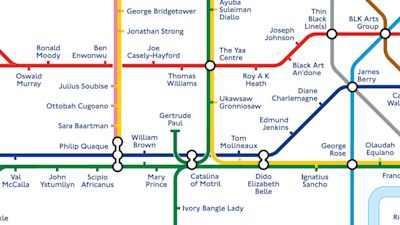London Underground map reimagined to to mark Black History Month

London’s Tube map has been reimagined to celebrate the contribution black people have made to British life throughout history.
The 272 station names have been replaced by notable black figures from pre-Tudor times to the present day.
They include the first black woman to serve in the Royal Navy, who disguised herself as a man called William Brown.
Other people featured are Victorian circus owner Pablo Fanque; composer and poet Cecile Nobrega, who led a 15-year campaign to establish England’s first permanent public monument to black women in Stockwell, south London; and Jamaican-born settler to Edinburgh John Edmonstone, who taught naturalist Charles Darwin taxidermy.
The map was produced by Transport for London in partnership with Black Cultural Archives, a cultural centre in Brixton, south London.
London mayor Sadiq Khan said: “Black history is London’s history and this reimagination of the iconic Tube map celebrates the enormous contribution black people have made, and continue to make, to the success of our city.
“I’m determined to create a more equal city where black lives truly matter.
“This starts with education and that’s why this new black history Tube map is so important.
“It gives us all the chance to acknowledge, celebrate and learn about some of the incredible black trailblazers, artists, physicians, journalists and civil rights campaigners who have made such significant contributions to life in the capital, as well as our country as a whole.”
Black Cultural Archives managing director Arike Oke said: “London’s black history is deeply embedded in its streets and neighbourhoods.
“We’re delighted, as part of our 40th anniversary celebrations, to use this opportunity to share new and old stories about black history with Londoners and visitors to London.
“We hope that the map will be an invitation to find out more and to explore.”